Is it possible to boost the success of Facebook posts by striking the perfect emotional chords? How can we do this and measure the effect of click-through-rate (CTR) to the company website? Social media posts are generally composed based on emotion – and with the help of social sentiment analyses, it’s possible to find out which sentiments are most successful! We’ve been working with a specialist digital analytics expert who has examined over 11,000 Facebook posts from five NGOs (Non-Governmental Organisations) – with astounding results.
What effect does the emotional coding of a Facebook post have on user interaction? How can we filter out key performance indicators from the flood of unstructured data and use them to reliably achieve our social media aims? An analysis of the emotional targeting of Facebook posts and the resulting user interaction trends provides the answers …
Step one: filter out the important stuff
The aim of our investigation was to measure the effect of the emotional orientation of Facebook posts on interaction rates – in other words: likes, comments and shares. So we analysed 11,000 posts from five NGO Facebook fan pages which had already lead to interactions. Step one: data pre-processing and transformation. This is where we prepare the texts in such a way that only they only contain data which can be analysed, without the other unstructured information. This involved three sub-steps:
- Remove stop-words: Stop-words are terms which don’t give a text any direct meaning. They are often grammatic or syntactical, such as articles (a, an, the), conjunctions (and, or, but) or prepositions (on, in, with).
- Stemming: Stemming involves reducing words which have grammatically altered back to their original meaning. For example, the original meaning behind seeing, sees and saw is “see.”
- Emojis: Ok, smiling and crying faces are pretty obvious. But other emojis are more emotionally ambiguous. Neutral or emotionless smilies are therefore also filtered out.
What’s left is the quintessential meaning of the text which can be subjected to data mining – in other words, a scientific analysis. A complex algorithmic analysis to identify structures of meaning was carried out using so-called supervised leaning – a type of machine learning supported by humans.
Step two: creating a sentiment lexicon
Aving filtered out the important information, we then categorized the posts by tone – in two fundamental tones:
- Positive
- Negative
And eight additional, more specific emotions:
- Anger
- Anticipation
- Disgust
- Fear
- Joy
- Sadness
- Surprise
- Trust
Now, every word can be valued as positive or negative in a so-called sentiment lexicon, and also categorized into specific additional categories:
| Positive | Negative | Anger | Anticipation | Disgust | Fear | Joy | Sadness | Surprise | Trust | |
|---|---|---|---|---|---|---|---|---|---|---|
| Accident | 0 | 1 | 0 | 0 | 0 | 1 | 0 | 1 | 1 | 0 |
| achieve | 1 | 0 | 0 | 0 | 0 | 0 | 1 | 0 | 0 | 0 |
| court | 0 | 1 | 1 | 0 | 1 | 0 | 0 | 0 | 0 | 0 |
| admirable | 1 | 0 | 0 | 0 | 0 | 0 | 1 | 0 | 0 | 1 |
From this basis, we can produce an emotional value of the analysed Facebook posts. In the example below, the sentiment score can be presented as a bar chart showing the total number of sentiments In all of an NGI’s analysed posts.
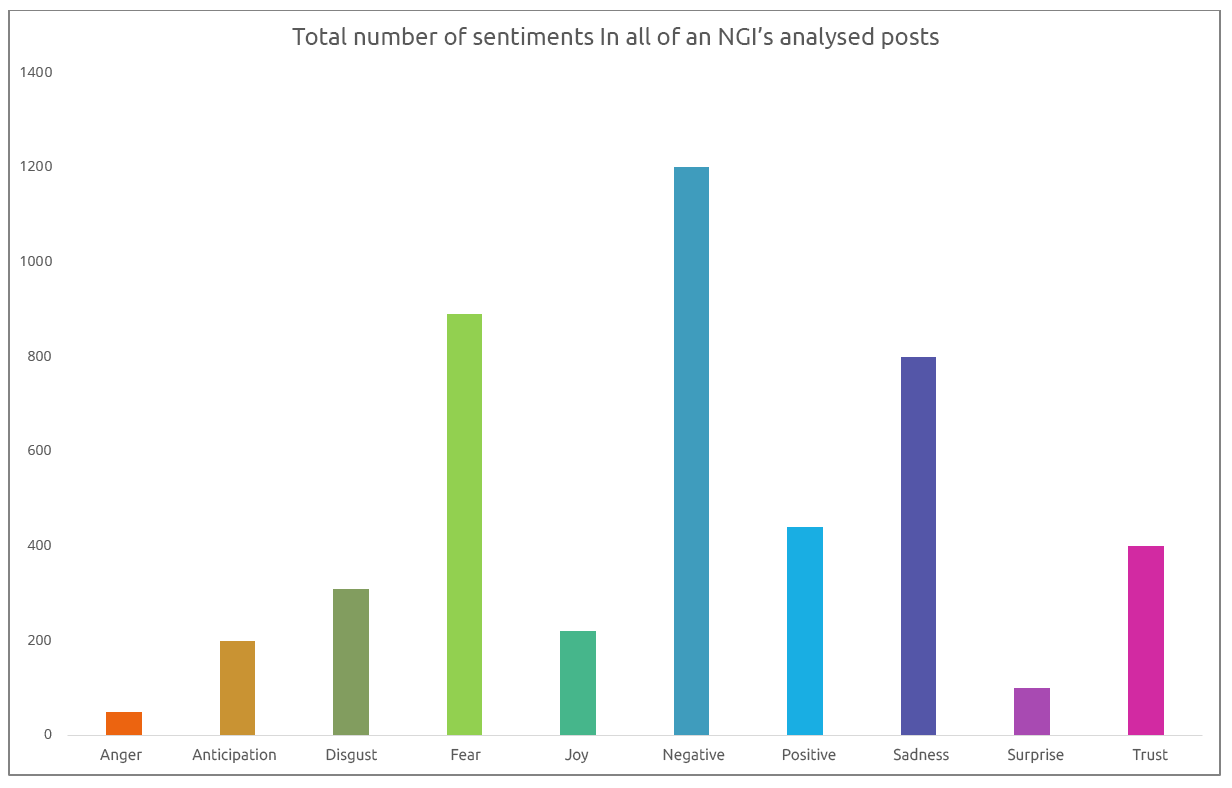
We can now calculate which sentiment performs best on Facebook – information which can be directly applied to our social media marketing.
How sentiment influences likes, comments & shares
A quick note: sentiments don’t affect the total interaction rate but rather the respective Social Signals. This means that a certain sentiment may generate more likes but could also reduce the number of comments and shares.
How does sentiment affect likes?
In our analysis, the sentiment of “joy” generates 37 per cent more likes compared to a neutral post. “Trust” generates 33 per cent fewer likes. Surprisingly, “positive” posts generated 25 per cent fewer likes!
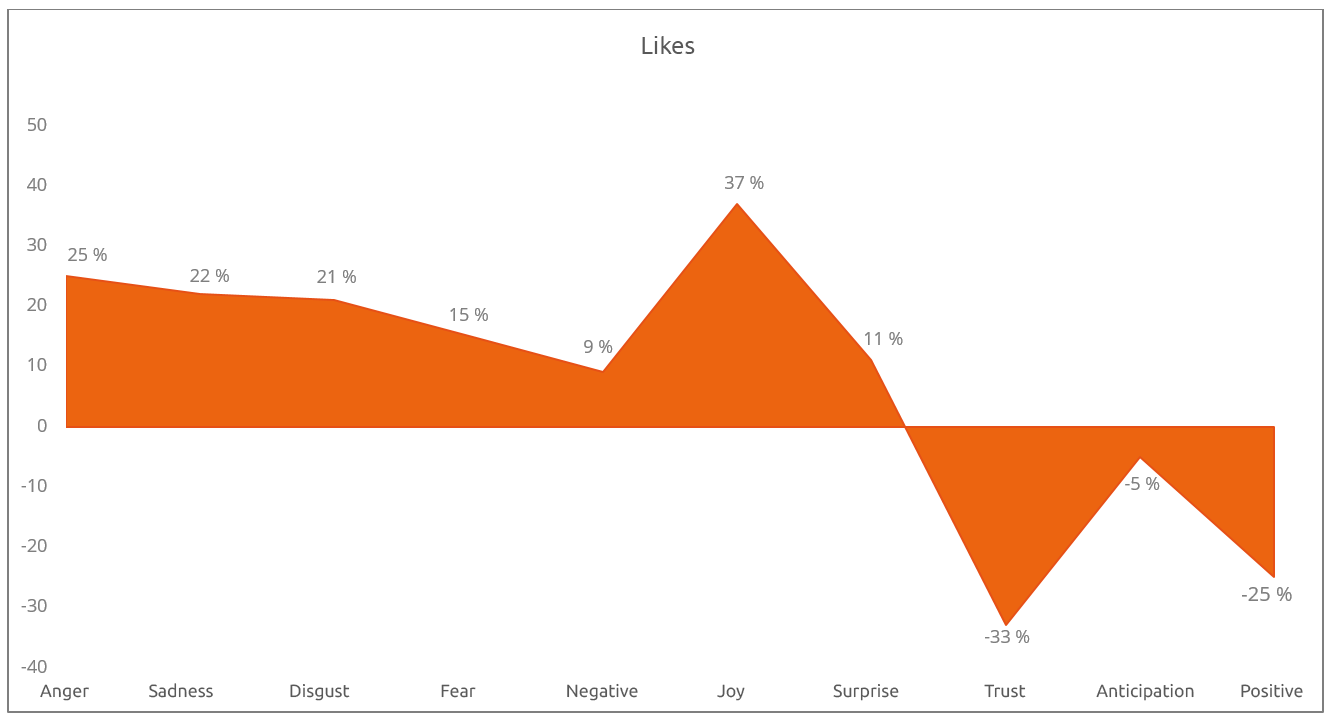
How does sentiment affect comments?
If the aim is to generate as many comments as possible, “negative” posts are shown to be counter-productive – at least as far as NGOs are concerned. According to our results, negative posts generate 63 per cent fewer comments. “Anger,” on the other hand, generates double the amount of comments!
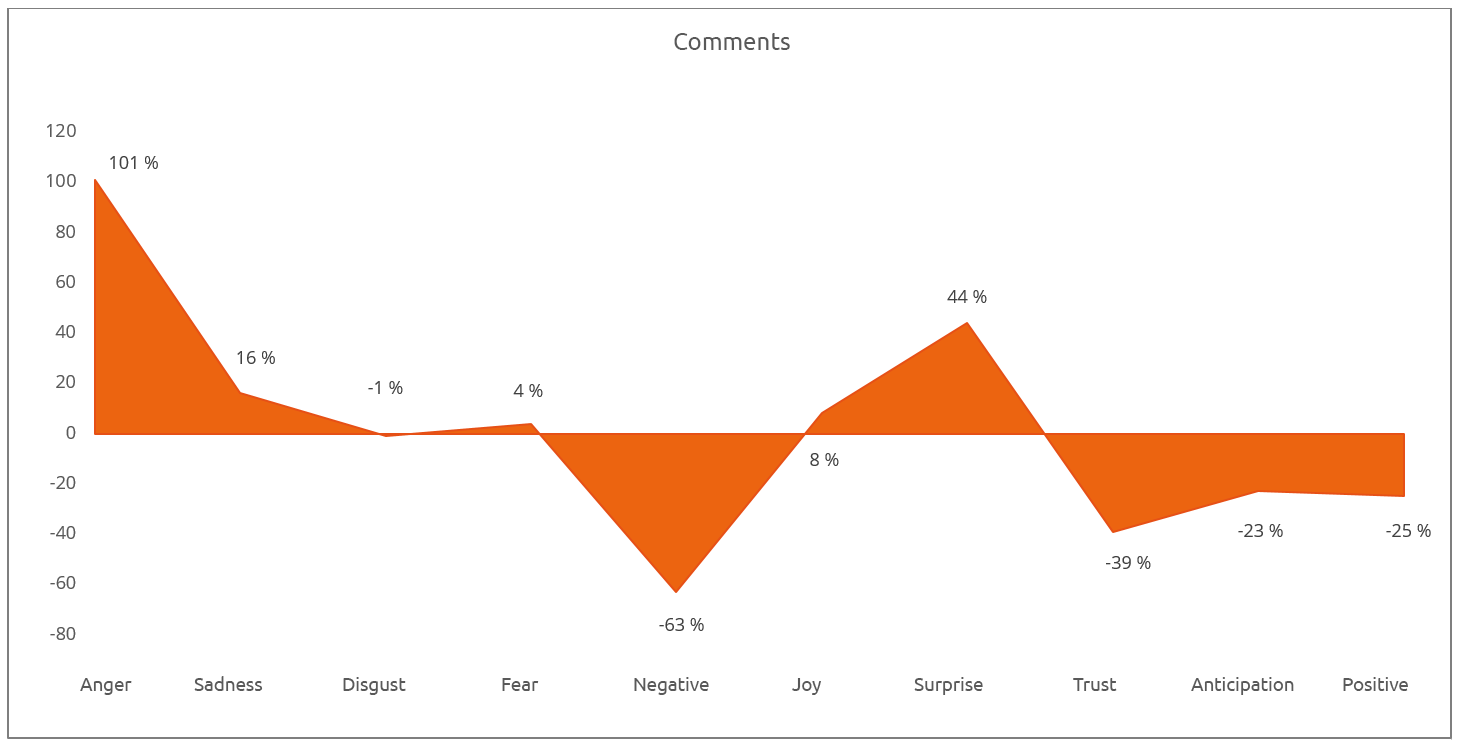
How does sentiment affect shares?
According to our research, the number of shares drops for positive posts and for posts associated with “trust” and “anticipation.” Shares increase by around 33 per cent when “anger” and “sadness” are involved.
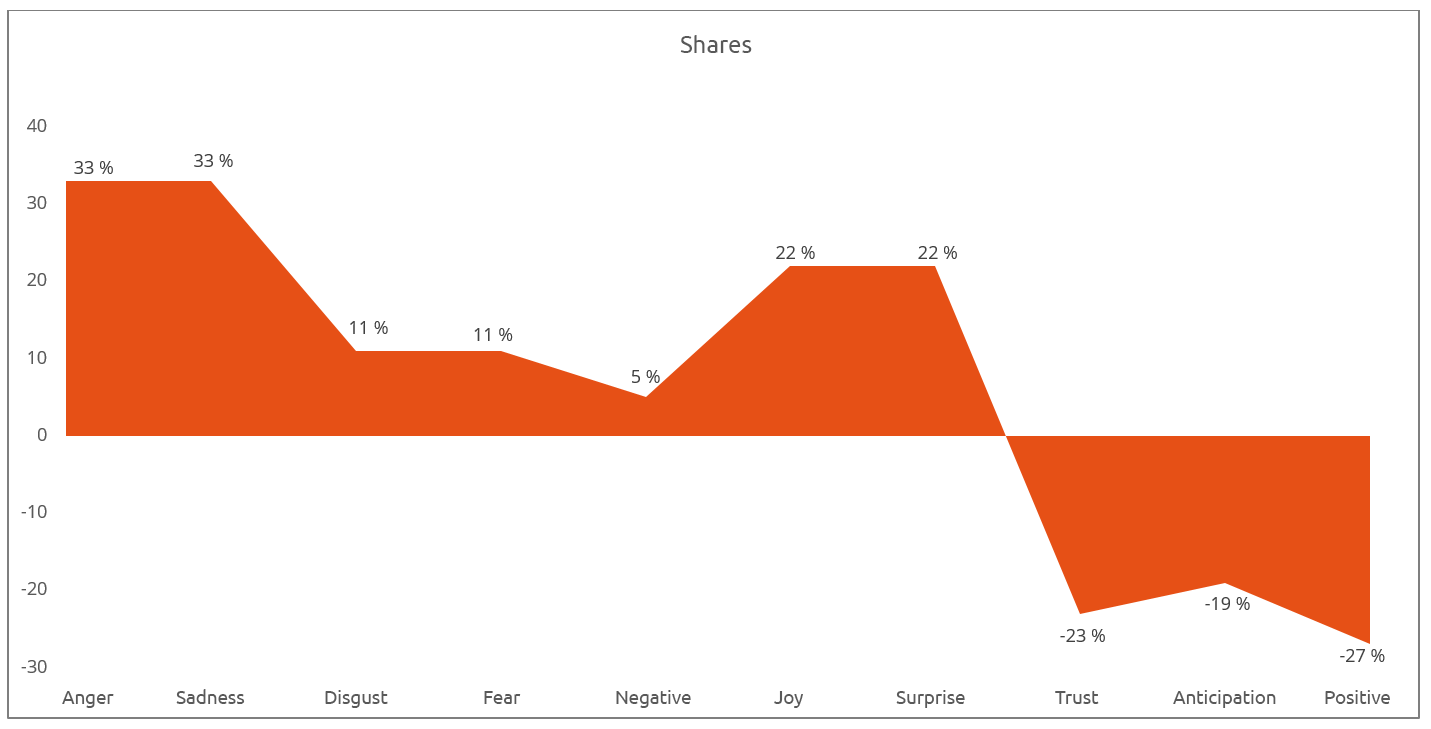
Sentiments in conjunction with other topics
Interaction rates aren’t just affected by sentiment alone but also by their emotional orientation in relation to particular topics and subject areas – for example, geographical locations.
For example, our research showed that when NGOs posted about Africa in a negative manner, Facebook interactions changed as follows:
- 28 per cent more likes
- 200 per cent more comments
- 22 percent more shares
When, on the other hand, NGOs posted about the Philippines, interaction rates changed according to their social signals:
- “Positive” posts generated 19 per cent more likes and 48 per cent more shares
- “Negative” posts generated 22 per cent more comments
When the subject of Facebook posts was illness or disease, positive sentiments boosted interaction massively – particularly, for example, on the subject of HIV:
- 288 per cent more likes
- 545 per cent more comments
- 425 more shares
Does emotional coding generate more website clicks?
As pleasing as higher interaction rates on Facebook undoutedly are, the primary function of a company’s Facebook page remains to direct fans from the social media platform to the webpage. Can this be influenced using sentiment? According to our findings: yes! We investigated posts containing a website link with the assumption that all fans saw the post. The result: when compared to neutral posts, all sentimental posts boosted click-rate. “Positive” sentiments were most successful (73 per cent clicks). “Fear” generated 14 per cent clicks.
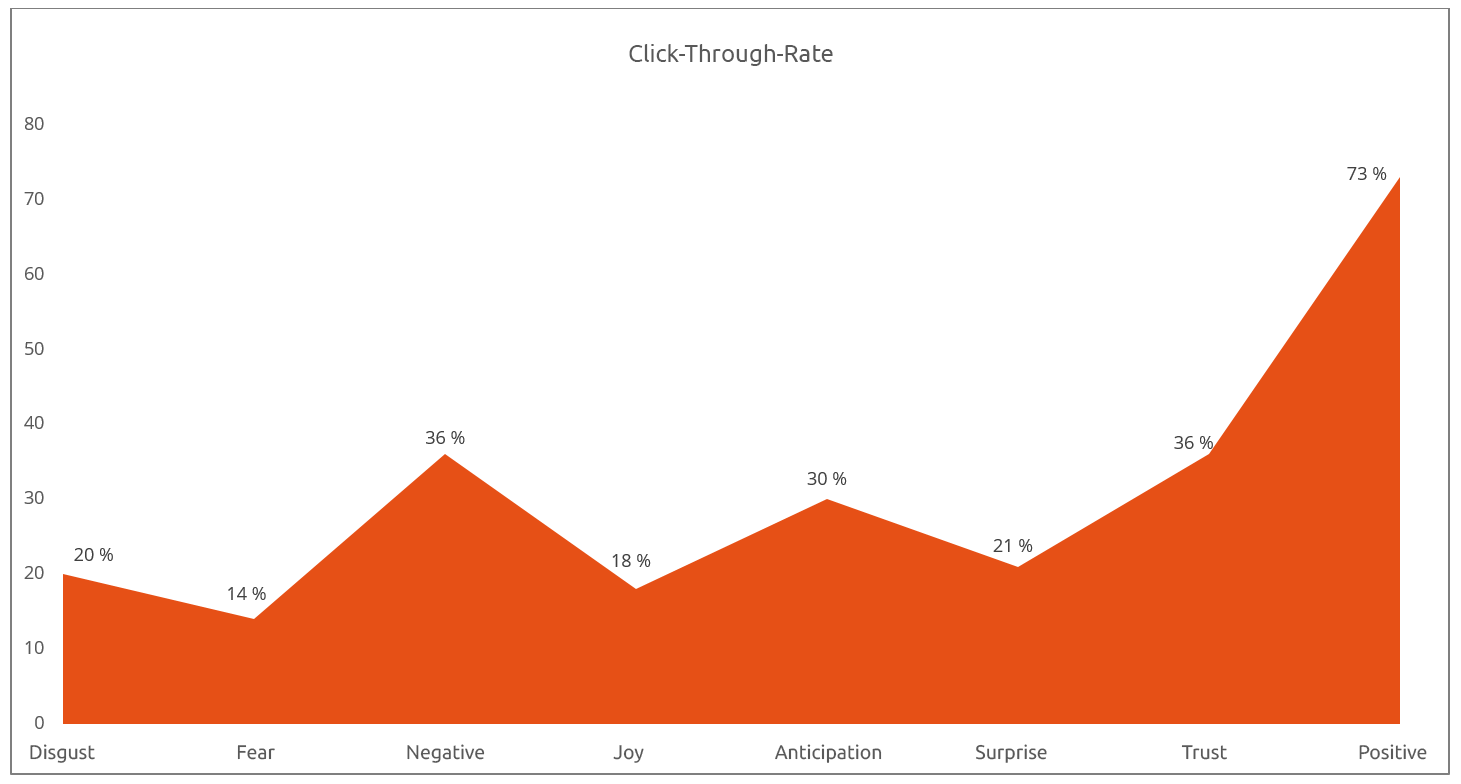
Conclusion: Yes, it it possible to boost your social media marketing using targeted emotional orientation!
Our research shows that sentiment can have a significant effect on NGOs’ social media presences:
- Sentiments influence interaction rates on Facebook
- Appropriate sentiments can boost interaction depending on subject area
- Sentiments can influence downstream assets
“Sentimental social” opens up a whole new range of opportunities for data-driven social media marketing – a huge chance for businesses who are active on social media.
 English
English

